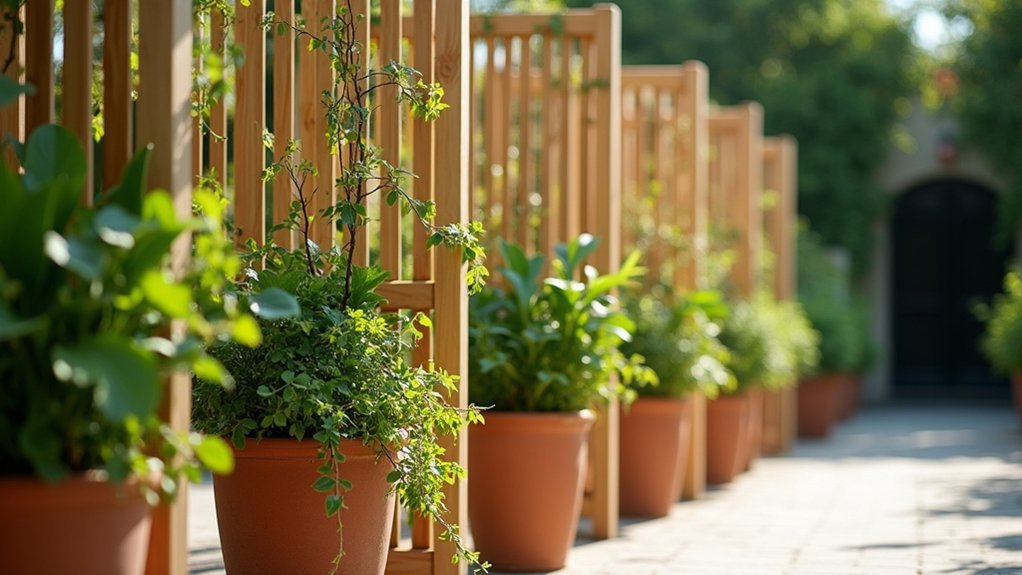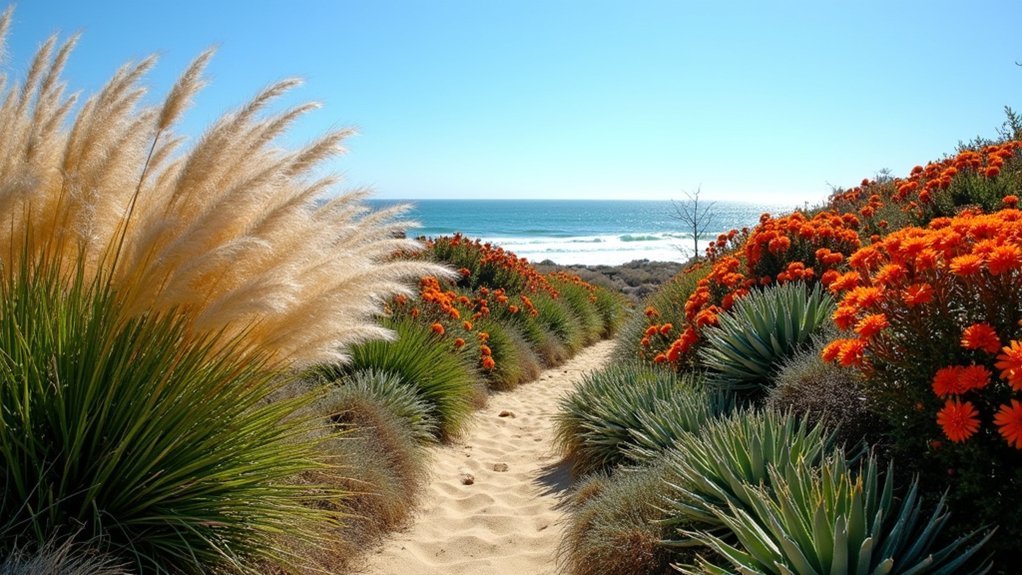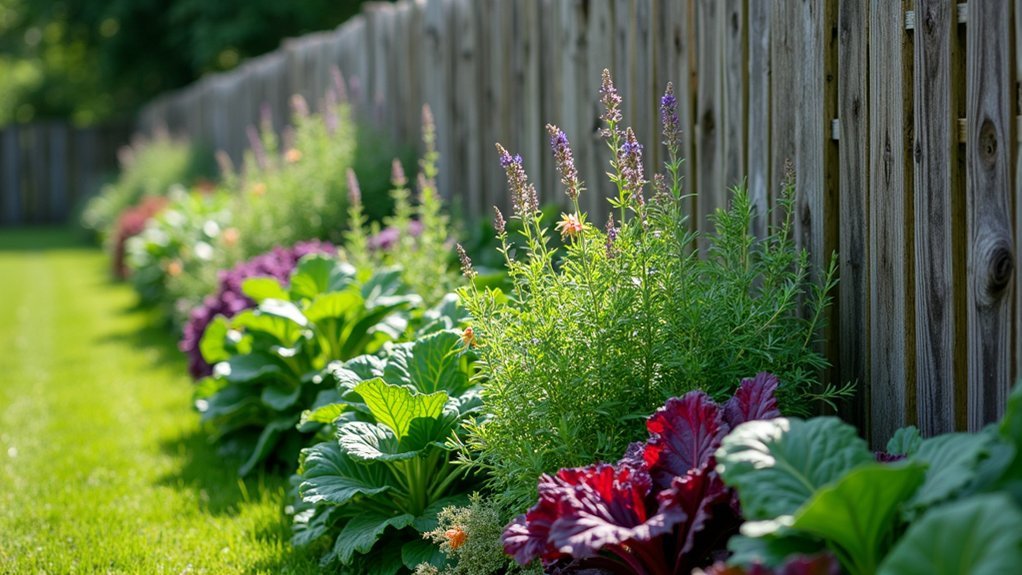Small space plant dividers offer multiple benefits for your compact growing area. They create distinct zones while maintaining openness, establish microclimates with varied light and humidity levels, and prevent root competition between aggressive and delicate species. You’ll maximize your growing capacity by up to 50% with vertical arrangements while reducing wind speed by 30% for better plant protection. Plant dividers also enhance pollinator access and allow flexible rearrangement as your needs change throughout seasons. Discover how these simple barriers transform limited space into thriving garden zones.
Why Build Small Space Plant Dividers?

While traditional room dividers can make small spaces feel cramped and closed off, plant dividers offer a rejuvenating change—literally. They create distinct zones in your space while maintaining an open, airy feel that doesn’t sacrifice visual flow.
Indoor plants used as dividers pull double duty by improving your air quality, filtering toxins, and boosting your overall well-being. They’re natural sound absorbers too, reducing noise levels and creating a more peaceful environment—perfect for shared apartments or busy home offices.
Plants don’t just divide spaces—they purify your environment and absorb unwanted noise while enhancing your mental state.
What makes plant dividers truly special is their adaptability. You can easily rearrange them as your needs change, without the commitment of permanent walls.
Even better, by choosing low-maintenance varieties, you’ll enjoy all these benefits without becoming a full-time gardener. It’s functionality and beauty working together.
Maximizing Limited Garden Real Estate
Every inch matters when you’re working with limited outdoor space. Small space plant dividers let you segment your garden strategically, allowing you to grow diverse plant species where traditional layouts would restrict variety.
By implementing these dividers, you’ll transform your compact garden into a highly efficient growing environment.
Vertical gardening techniques paired with dividers can boost your growing capacity by up to 50% compared to horizontal methods alone. Choose lightweight, movable dividers to easily reconfigure your setup as seasons change or as your gardening needs evolve.
Consider using compact plants like dwarf varieties or trailing vines for natural dividers that enhance visual appeal while maintaining proper air circulation.
Your dividers can serve dual purposes too—providing shade or acting as windbreaks—further optimizing functionality in your small space garden.
Creating Distinct Microclimates for Diverse Plants

By strategically placing small space plant dividers, you’ll create distinct zones with varied light levels and humidity conditions perfect for growing diverse plant species together.
You can separate temperature-sensitive plants effectively, protecting cool-loving ferns from heat-tolerant succulents while still maintaining visual harmony.
These microclimate divisions let you customize growing conditions within inches of each other, expanding the range of plants you can successfully nurture in limited space.
Light and Humidity Control
As your plant collection grows, you’ll need to accommodate species with varying environmental needs in a limited space. Plant dividers offer an elegant solution for light and humidity control in your compact garden.
By strategically arranging dividers, you can create specialized zones where humidity-loving ferns and peace lilies thrive separately from drought-tolerant succulents and cacti. Incorporate moss sections or water trays within divider compartments to maintain moisture pockets while keeping other areas drier.
Tall plants positioned in dividers can shield more delicate species from harsh direct sunlight, creating essential shadowed areas. These natural barriers also protect sensitive plants from drafts that could otherwise damage them.
You’ll maximize your small space’s potential by establishing these microenvironments, allowing each plant to receive its ideal light exposure and humidity level.
Temperature Zone Separation
Temperature variations present a challenge even in the smallest growing spaces. With strategic plant dividers, you’ll create effective temperature zone separation, maintaining ideal conditions for diverse plant species living side by side. Plant dividers act as thermal barriers, buffering temperature fluctuations and creating stable microclimates.
| Divider Type | Temperature Benefit | Ideal Plants |
|---|---|---|
| Solid Panels | Blocks heat transfer | Heat-sensitive ferns |
| Porous Screens | Gradual temperature gradient | Mixed collections |
| Heat-retaining | Maintains warmth overnight | Tropical varieties |
| Reflective | Redirects excess heat | Desert succulents |
| Terraced | Utilizes rising warm air | Layered ecosystems |
Preventing Plant Competition and Root Overcrowding
You’ll notice dramatic improvement in your garden when you separate plants with dividers that give each root system the space it needs to flourish.
By preventing the fierce underground competition for nutrients and water, these simple barriers help individual plants grow stronger and develop more robust root structures.
Your plants will reward you with healthier foliage and more abundant blooms as they thrive in their own dedicated spaces rather than struggling against neighboring species.
Roots Need Space
Plant roots, the hidden workhorses beneath the soil, require ample room to thrive in your small space garden.
When you provide proper spacing between plants, you’re ensuring each root system can access the nutrients, water, and minerals it needs without fierce competition.
Consider these facts about root space requirements:
- Roots can extend surprisingly far—tomato plants reach up to three feet underground.
- Overcrowded roots lead to stunted growth and reduced harvest yields.
- Plant dividers help maintain ideal spacing for healthy root development.
- Experts recommend maintaining at least 3/4 of the suggested spacing between plants.
Stronger Individual Plants
A well-designed divider system creates the foundation for stronger, more robust individual plants in your small space garden. When each plant has its designated area, roots don’t compete for essential resources, allowing them to develop fully and support healthier growth.
You’ll notice your plants establish more vigorous root systems when they’ve clear boundaries. These defined spaces prevent overcrowding, which often leads to nutrient deficiencies and stress. With dividers, each plant receives adequate water, nutrients, and light without having to compete with neighbors.
This separation also greatly reduces disease transmission between plants, creating a harmonious growing environment where pathogens can’t easily spread.
Natural Privacy Solutions for Compact Areas

When space comes at a premium, creating privacy doesn’t have to mean building walls or sacrificing your home’s open feel. Small space plant dividers offer an elegant solution that maintains light flow while establishing distinct zones in your compact living area.
These natural barriers work brilliantly by:
Living green dividers elegantly separate spaces while enhancing your environment with beauty, cleaner air, and acoustic benefits.
- Creating visual separation without blocking natural light or air circulation
- Filtering indoor air pollutants while adding vibrant greenery to your space
- Absorbing ambient noise for a more peaceful environment
- Requiring minimal floor space when arranged vertically or in tiers
You’ll appreciate how these living dividers transform open-concept designs into cozy, private nooks.
Choose low-maintenance options like Snake Plants or Peace Lilies if you’re busy but still want the benefits of a natural privacy screen.
Vertical Growing Opportunities in Minimal Footprints
Despite having limited floor space, you can transform your compact home into a lush paradise by thinking upward.
Vertical plant dividers maximize your green potential by utilizing wall space rather than precious floor area, creating visual impact without sacrificing functionality.
Incorporate wall-mounted planters and trellises to dramatically increase your plant density while maintaining an open feel.
Climbing varieties like Pothos and Monstera thrive in these vertical growing opportunities, offering abundant foliage with minimal horizontal footprint.
Multi-tiered vertical systems allow you to grow diverse plant collections in even the smallest apartments.
You’ll notice improved plant health too—vertical arrangements naturally enhance air circulation and light exposure, ensuring your green companions flourish.
When space is tight, the solution isn’t fewer plants—it’s smarter placement.
Aesthetic Zoning Without Permanent Structures

Creating distinct functional areas in open-concept spaces doesn’t require construction crews or permanent walls.
Plant dividers offer a dynamic solution for aesthetic zoning that adapts as your needs evolve.
- Visual boundaries – Strategically placed plants create intuitive pathways and separate areas while maintaining an open, airy atmosphere.
- Organic texture – Living dividers soften harsh architectural lines and introduce natural elements that improve wellbeing.
- Flexible design – Unlike built-in partitions, you can rearrange plant groupings whenever your space demands change.
- Layered interest – Combining various heights, textures, and species adds depth and visual intrigue without blocking sightlines.
Protecting Delicate Species From Aggressive Growers
Your plant dividers create essential root boundaries that shield ferns, orchids, and other delicate plants from being overwhelmed by aggressive species like mint or bamboo.
These physical barriers prevent invasive roots from overtaking precious soil space, allowing vulnerable varieties to maintain their foothold in your garden ecosystem.
You’ll notice improved health in your sensitive plants as they benefit from having their own protected zone where they can access nutrients without competition from their more vigorous neighbors.
Root Boundary Benefits
While small-space gardening encourages plant diversity, it also creates potential territory battles beneath the soil. Installing root boundaries prevents aggressive species like bamboo or mint from dominating your garden’s limited real estate.
You’ll protect sensitive plants while creating balanced growing conditions for all your green companions.
Root boundaries deliver four key benefits:
- Prevent resource theft – Stop aggressive roots from stealing water and nutrients meant for delicate species
- Reduce disease spread – Improve drainage to minimize root rot in moisture-sensitive plants
- Create microenvironments – Help moisture-loving plants like hostas and ferns maintain ideal conditions
- Promote plant longevity – Guarantee each species thrives without stress from competing root systems
With proper dividers in place, you’ll enjoy a healthier, more diverse garden where every plant has room to flourish.
Preventing Cross-Variety Takeovers
Beneath the soil’s surface, a silent battle for territory unfolds when aggressive plants share space with more delicate varieties. Without intervention, plants like mint and bamboo quickly overshadow their vulnerable neighbors, competing for essential resources and potentially causing their demise.
Plant dividers create vital physical barriers that halt aggressive root systems in their tracks. By preventing cross-variety takeovers, you’re ensuring each species maintains its own space to flourish.
These barriers also help preserve specific soil conditions that delicate plants need to thrive, protecting them from invasive neighbors that might alter pH or moisture levels.
You’ll find it easier to monitor and manage each plant type with dividers in place, allowing for targeted care without disrupting neighboring species. The result? A more organized garden where both aggressive and delicate varieties coexist peacefully.
Weather Protection and Wind Barrier Benefits

Although often overlooked, small space plant dividers serve as remarkable weather shields for your outdoor sanctuary.
These natural barriers can reduce wind speed by up to 30%, creating a protected microclimate that helps your delicate plants thrive even in challenging conditions.
When you strategically position these dividers, you’ll experience:
- Reduced soil erosion and moisture loss, keeping your plants properly hydrated
- Temperature regulation with less soil fluctuation, protecting sensitive root systems
- Protection for delicate flowers and vegetables against harsh weather conditions
- Enhanced growing potential as plants focus energy on growth rather than surviving elements
For maximum weather protection, incorporate wind-resistant species like evergreens into your dividers.
You’ll create not just visual separation but a functional shield that transforms your garden’s growing environment.
Enhancing Pollinator Access in Confined Spaces
Even the smallest urban spaces can become vibrant pollinator havens when you design plant dividers with biodiversity in mind. Your strategic placement of dividers featuring plants with pollinator-friendly characteristics creates microhabitats that support essential ecological functions.
Choose flowering varieties like lavender and coneflowers that offer abundant nectar and pollen sources. You’ll notice increased visitation from bees, butterflies, and beneficial insects once these resources become available in your confined space.
| Plant Type | Benefits | Best Placement |
|---|---|---|
| Lavender | High nectar content | Sunny edges |
| Coneflowers | Long blooming period | Central areas |
| Native wildflowers | Shelter and nesting sites | Throughout divider |
Seasonal Rotation and Adaptable Boundaries
As seasons change, your plant dividers should evolve to maintain visual interest and optimize growth conditions throughout the year.
Implementing seasonal rotation guarantees your green boundaries remain vibrant while adaptable boundaries allow for workspace flexibility as your needs shift.
Consider these benefits of rotating your plant displays:
- Enhanced aesthetics – Different species thrive in varying light conditions, providing year-round visual appeal.
- Improved plant health – Prevents overcrowding and guarantees adequate light for all varieties.
- Increased workspace flexibility – Easily reconfigure dividers to accommodate changing office layouts.
- Better employee engagement – Seasonal themes foster connection to nature and promote mindfulness.
You’ll find that regularly renewing your plant dividers not only keeps your space looking fresh but also contributes to a more inviting work environment.
Frequently Asked Questions
How to Use Plants as Room Dividers?
You can use tall plants like Fiddle-Leaf Figs to create vertical dividers. Group varieties with different heights and textures, use movable containers, incorporate hanging plants, and position them strategically to define separate areas.
When to Use a Room Divider?
You should use a room divider when you’re creating distinct zones in one space, need privacy, want to define areas in open plans, or require flexible spatial arrangements that can adapt to your changing needs.
Why Is It Important to Space Plants?
Proper spacing guarantees your plants won’t compete for nutrients, water, and light. You’ll promote better air circulation, prevent disease, and allow roots to develop fully. Plants that aren’t crowded grow stronger and produce higher yields.
How Do You Display Plants in Small Spaces?
You’ll maximize small spaces by mounting wall shelves, using multi-tiered stands, choosing compact plants, installing decorative boxes on ledges, and grouping similar plants together. Don’t forget to utilize vertical space for an attractive display.
In Summary
You’re not just maximizing space when you build small dividers—you’re creating a harmonious ecosystem for your plants. They’ll thrive with personalized microclimates, protection from aggressive neighbors, and barriers against harsh weather. Your compact garden will become a well-organized sanctuary where diverse species coexist without competition. Whether for privacy, pollinator pathways, or seasonal rotations, these simple boundaries transform limited square footage into a productive plant paradise.





Leave a Reply